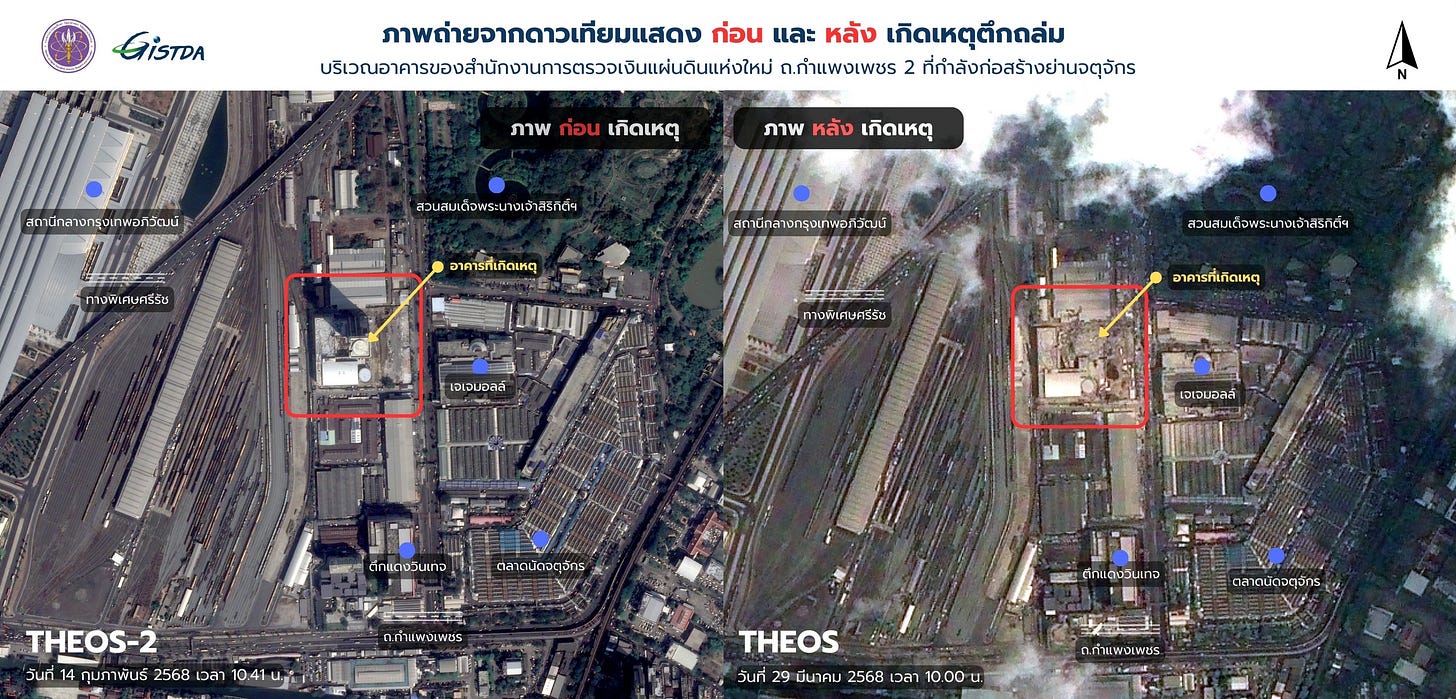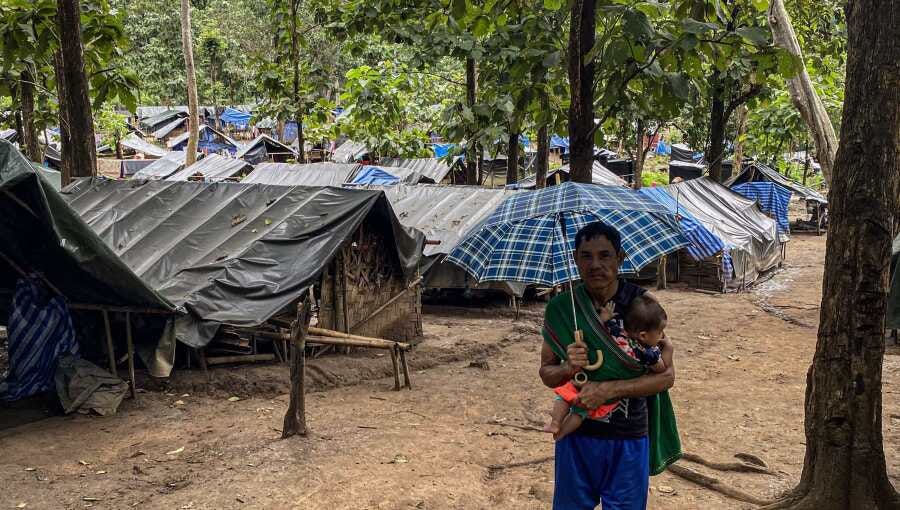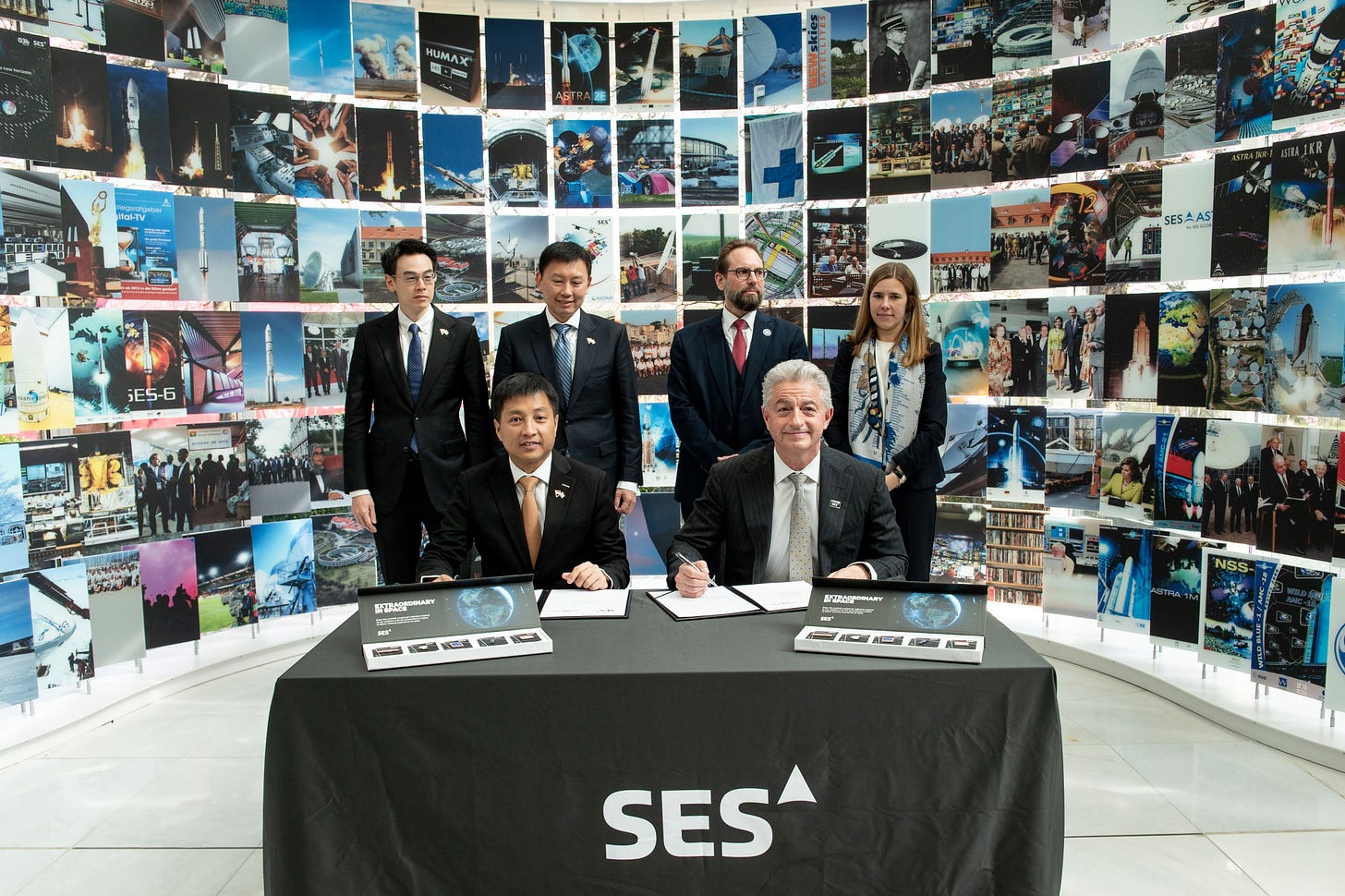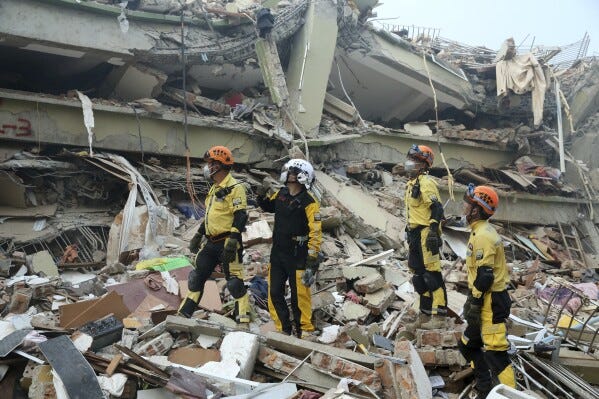Southeast Asia Space Roundup: 27 March to 2 April 2025
A summary of all the space news in Southeast Asia over the past week, brought to you by AzurX

The following are the major space developments in the Southeast Asian region tracked by Southeast Asia Space Monitor over the past week:
Myanmar, Thailand Earthquake Response: The Role of Satellites
Satellite Support Major Part of ASEAN’s Response to Myanmar. Thailand Earthquake Zones
In response to the devastating 7.7-magnitude earthquake and aftershock that struck near Mandalay, Myanmar, the AHA Centre has launched a full-scale international relief operation, leveraging space-based assets to support disaster response. Crucially, satellite imagery analysis has been activated via Sentinel Asia and UNOSAT’s Space Charter, with additional GIS mapping support from MapAction, to provide real-time Earth observation and remote sensing data. These capabilities are being used to assess damage, guide urban search and rescue (USAR) deployments, and enhance situational awareness across the affected zones. The integration of satellite-derived information is central to the coordinated efforts led by the AHA Centre and ASEAN partners, including the deployment of emergency response teams from Singapore, Malaysia, Indonesia, and others, as well as the distribution of relief items from the DELSA warehouse. This event underscores the critical role of Earth observation technologies in disaster risk management and humanitarian response across Southeast Asia.
Earth Observation Satellites and AI Combine to Provide Targeted Insights for Myanmar Earthquake Response
In the aftermath of the 7.7-magnitude earthquake that struck Mandalay, Myanmar, satellite and AI technologies played a pivotal role in supporting disaster response. A collaboration between Planet Labs and Microsoft’s AI for Good Lab used high-resolution satellite imagery and customized AI models to assess structural damage across the affected city. Initial efforts were delayed by cloud cover, but once clear imagery was captured, Microsoft’s tailored computer vision model identified over 2,000 damaged buildings, including 515 with near-total destruction. This rapid AI-driven analysis, which Planet Labs supported with imagery from its fleet of 15 Earth observation satellites, has provided critical geospatial insights to aid organizations, including the Red Cross, enabling more targeted and efficient ground-level response. The initiative underscores the growing role of satellite remote sensing and AI in real-time disaster management, while also highlighting the continued need for field verification to complement automated assessments.
Thailand’s Space Sector Rallies to Support Earthquake Response Efforts
In response to the recent earthquake in Mandalay, Myanmar, AIS, THAICOM, and Thailand's National Broadcasting and Telecommunications Commission (NBTC) have jointly extended their support for emergency relief efforts, with a focus on ensuring robust communication infrastructure. AIS is providing complimentary roaming services and direct emergency contact support for Thai citizens and medical teams in Myanmar through its 24-hour call center and coordination with the Ministry of Defence. Concurrently, THAICOM is enhancing emergency connectivity by deploying satellite dishes near relief zones to boost WiFi access, leveraging its satellite communications network. This initiative highlights the critical role of satellite-based connectivity in disaster response operations, ensuring uninterrupted communications for humanitarian teams operating in affected areas.

SpaceX Offers Rapid Deployment of Starlink Kits to Myanmar & Thailand After Devastating Earthquake
In response to the devastating 7.7-magnitude earthquake affecting Myanmar and Thailand, SpaceX has expressed readiness to deploy Starlink satellite kits to aid emergency communications, contingent on securing necessary governmental approvals. The offer comes amid significant infrastructure damage, with reports indicating up to 90% of Myanmar’s internet and telephone services were disrupted by the quake. However, the gesture has sparked political scrutiny given Elon Musk’s ties to President Donald Trump and the recent dismantling of U.S. humanitarian agencies like USAID. In Myanmar, internet access was already heavily restricted due to ongoing military censorship since the 2021 coup, which saw the junta seize control of major telecom providers and impose widespread surveillance and social media bans. Starlink’s potential deployment could offer a critical lifeline in a country plagued by digital blackouts, although its implementation may face resistance from an authoritarian regime that has previously driven out international telecom operators and restricted independent communications infrastructure.
Myanmar’s Internet & Telecoms Blackout Forces Those With Means to Satellite Connectivity
The recent 7.7-magnitude earthquake in central Myanmar has underscored the critical role of satellite connectivity in crisis communication, especially in politically restrictive environments. While neighboring Thailand was able to extensively document and share images and videos of the disaster online, Myanmar’s information blackout—fueled by military-imposed internet shutdowns and tight control over telecommunications—has severely limited public awareness and the coordination of aid. In regions where ground infrastructure is unreliable or intentionally disrupted, such as areas controlled by ethnic resistance groups, residents have increasingly turned to satellite-based internet services like Starlink to access the outside world. This highlights the growing importance of satellite communications in maintaining connectivity during both natural disasters and authoritarian-imposed blackouts. As Myanmar's official channels also went offline following the quake, the reliance on resilient, satellite-enabled networks becomes even more apparent in ensuring the continuity of communication and humanitarian response in contested or disaster-stricken regions.
Singapore Space Developments

Singapore’s SpeQtral and SES Sign MoU for Satellite-Based Quantum Key Distribution
SES and Singapore-based SpeQtral have signed a Memorandum of Understanding to jointly develop an interoperable Optical Ground Station (OGS) that will enable long-distance satellite-based Quantum Key Distribution (QKD) between Asia and Europe, marking a major step toward establishing a global quantum-secure communications network. The partnership will link SES’s European QKD initiatives—such as the ESA-backed EAGLE-1 project—with SpeQtral’s Singapore-led satellite missions SpeQtre and SpeQtral-1, supported by the Office for Space Technology & Industry (OSTIn). The proposed OGS, to be first deployed in Singapore, will integrate with local fibre-QKD infrastructure and act as a bridge to future satellite-enabled QKD services, reducing the cost and complexity of quantum communications. This collaboration addresses key infrastructure gaps in QKD availability and interoperability, aiming to catalyze the development of secure, global quantum networks. It also positions Singapore as a regional hub for quantum innovation, while enabling SES to expand its reach beyond the EU and offer ultra-secure connectivity solutions to a broader market. The MoU was signed in Luxembourg during Singapore President Tharman Shanmugaratnam’s state visit, underscoring the strategic importance of this transcontinental quantum partnership.
Singapore’s Maritime & Port Authority Signs MoU for Geospatial Solutions, Maritime Digital Twin
At Singapore Maritime Week 2025, the Maritime and Port Authority of Singapore (MPA) announced two major memoranda of understanding (MOUs) to bolster the country's maritime geospatial capabilities and talent pipeline. The first, a three-year partnership with key industry and academic stakeholders—including Jurong Port, Singapore Cruise Centre, and tech firms like Esri Singapore and Hexagon—focuses on applying geospatial technologies, such as satellite imagery and sensor-based 3D mapping, to enhance port operations, environmental monitoring, and risk management. In parallel, MPA signed a separate MOU with the National University of Singapore to establish maritime geospatial education programs for students and mid-career professionals. These developments coincide with the launch of Singapore’s first Maritime Digital Twin, a real-time virtual port model developed with GovTech that enables dynamic vessel tracking and underwater hull inspections. Collectively, these initiatives signal Singapore’s strategic push to integrate advanced geospatial intelligence and digital infrastructure into its maritime ecosystem, reinforcing its position as a global smart port leader.
Vietnam Space News
Starlink to Set Up 15 Ground Stations in Vietnam After Receiving LEO SATCOM License
SpaceX is preparing to establish a ground station for its Starlink satellite network in Danang, Vietnam, as part of a larger plan to deploy up to 15 such stations across the country, according to sources cited by Reuters. This initiative—enabled by a special five-year pilot program that allows Elon Musk to retain full control of the local subsidiary—signals Vietnam’s strategic move to attract U.S. tech investment amid potential tariff pressures from Washington. The Vietnamese government, while historically cautious on foreign tech ownership, appears to be offering this concession as an “olive branch,” particularly given Starlink’s potential to bolster secure internet services and maritime surveillance via satellite connectivity. The establishment of ground stations not only optimizes Starlink’s service capabilities in remote areas but also aligns with Vietnam’s insistence that all internet traffic flow through regulated gateways for security and data control. With Starlink authorized to serve up to 600,000 customers and a ground station investment estimated at $3 million, SpaceX is positioning itself for deeper involvement in Vietnam’s digital and industrial infrastructure, potentially backed by a broader $1.5 billion commitment.
Vietnam’s National Remote Sensing Centre in Talks With Airbus on VNREDsat-1 Ground Station Maintenance Contract
Vietnam's National Remote Sensing Centre is currently in negotiations with Airbus Defence and Space (ADS) to secure a maintenance contract for the ground station supporting VNREDsat-1, the country's first Earth observation satellite. This development underscores Vietnam's continued commitment to maintaining and leveraging its domestic satellite infrastructure for Earth observation and remote sensing capabilities. The VNREDsat-1 program, launched in 2013 with support from ADS, plays a crucial role in environmental monitoring, land use management, and disaster response. Renewed collaboration with Airbus reflects Vietnam’s intent to sustain operational readiness and technical performance of its satellite assets amid growing regional demand for geospatial intelligence.
Other Regional Space Developments

Thailand and India Deepen Space and Satellite Cooperation As Part of New Strategic Partnership
During Prime Minister Narendra Modi’s upcoming official visit to Bangkok, Thailand announced that bilateral relations with India will be elevated to a Strategic Partnership, with a strong emphasis on deepening cooperation in space technology and satellite applications. Among a broad array of strategic, economic, and cultural discussions, both governments are expected to formalize agreements that expand joint initiatives in science, technology, and innovation, specifically highlighting India’s leadership in space-based capabilities. This includes potential collaboration in satellite technology for Earth observation, telecommunications, and navigation systems, reflecting a shared interest in leveraging space assets for development, security, and regional integration. As India continues to enhance space cooperation across ASEAN under its “Act East” policy, and Thailand pursues its complementary “Act West” strategy, the upcoming summit signals a strategic pivot towards integrating space-based solutions into broader geopolitical and economic frameworks.
Malaysia’s Space Sector Launches SpaceTech Malaysia Association
Malaysia has taken a significant step toward establishing itself as a regional space technology leader with the formal launch of the SpaceTech Malaysia Association (SMA), a national body aligned with the country's National Space Policy 2030 and Malaysia Space Exploration 2030 (MSE2030) framework. Announced during its inaugural Annual General Meeting, SMA will serve as a strategic platform uniting stakeholders across government, academia, industry, and investment to drive space sector growth. Under the leadership of Datuk Dr. Sean Seah, SMA aims to accelerate domestic satellite infrastructure, AI-integrated space applications, and global collaboration to reduce foreign dependency and bolster national security, economic resilience, and disaster management capabilities through space-derived data. With six major initiatives already underway and planned representation at leading international space forums such as the International Astronautical Congress and APSCC Summit, SMA's formation signals Malaysia’s intent to secure a competitive role in the projected $1 trillion global space economy by 2040.
Philippine Space Agency Issues National Warning Over China’s Long March-7A Rocket Launch
The Philippine Space Agency (PhilSA) has confirmed the launch of China’s Long March-7A rocket on 30 March 2025, from the Wenchang Space Launch Site, with projected rocket debris expected to have fallen into designated maritime drop zones near northern Philippine waters. While the debris—comprising components such as boosters and fairings—was not anticipated to impact land or inhabited areas, PhilSA issued warnings regarding the risk it poses to ships, aircraft, and coastal communities. The agency highlighted the potential for some debris to float or drift ashore and stressed that remnants may contain hazardous substances like rocket fuel. A Notice to Airmen (NOTAM) was issued in advance to alert of aerospace flight activity, and PhilSA disseminated pre-launch advisories to national authorities. The incident underscores the growing regional implications of space launches and the need for robust protocols to manage debris risks, particularly in Southeast Asia's congested maritime zones.

Indonesia to Appeal French Court Decision Over Navayo International Satellite Dispute
Indonesia is preparing to appeal a French court's decision allowing the seizure of its diplomatic residences in Paris, following an arbitration award favoring Liechtenstein-based Navayo International AG over a failed 2016 satellite contract. The dispute stems from a $16 million claim brought by Navayo after the Indonesian Ministry of Defense canceled the project, with the arbitration tribunal in Singapore ruling in Navayo’s favor. The award has since ballooned to over $24 million due to penalties. Indonesia, citing evidence of fraud and unfinished work—amounting to just $114,000—refused to pay, prompting Navayo to pursue asset seizure in France. Legal Affairs Minister Yusril Ihza Mahendra, calling the action a breach of the Vienna Convention on Diplomatic Relations, is seeking reversal of the court’s decision in a hearing scheduled for May. Jakarta has also initiated fraud proceedings against Navayo and is pursuing an Interpol red notice. The case highlights growing legal and diplomatic risks surrounding international satellite agreements and underscores the importance of rigorous contract governance in state-backed space projects.
India’s Instrumental Role in Supporting Islamic Countries’ Space Programs
India’s upcoming launch of two Indonesian satellites via the Indian Space Research Organisation (ISRO) continues a decade-long space partnership and highlights New Delhi’s growing role as a trusted space collaborator for Muslim-majority countries. Through its cost-effective launch capabilities and technological reliability—evident in record-setting missions like Chandrayaan-3 and the PSLV-C37 multi-satellite deployment—India has cemented its reputation as a key enabler of space access for the Global South. Between 2015 and 2025, ISRO launched over 430 foreign satellites, with many originating from Islamic countries such as Indonesia, UAE, Malaysia, Nigeria, and Egypt. Beyond launches, India has supported partners like Brunei, Nigeria, and Kuwait in building ground infrastructure, satellite systems, and human capital via training and MoUs. Egypt, with ambitions for regional space leadership, has deepened collaboration with India following President El-Sisi’s 2023 visit, while Oman has requested Indian support in setting up a ground station and developing remote sensing capabilities. These partnerships underscore ISRO’s dual mission of advancing sustainable development and strengthening India’s geopolitical outreach through space diplomacy.
Be sure to catch up with space activities in the region in the next edition of Southeast Asia Space Monitor’s space roundup!






